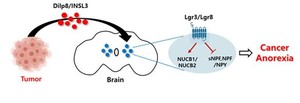
[뉴스워치= 윤영의 기자] Researchers in Korea discovered the mechanism by which a specific protein (peptide) secreted specifically from cancer cells regulates appetite-regulating hormones through specific receptors in the cranial nerve cells, and identified the causes of eating disorders in patients.
Accordingly, if it leads to the development of a therapeutic agent that can regulate the signaling system by a specific protein in the future, it is expected that the effect of chemotherapy can be greatly improved through the improvement of eating disorders in cancer patients.
As cancer progresses, it is known that tumor tissues and cancer cells secrete various cancer secretion factors and inflammation-inducing factors to reduce normal tissue function, thereby causing complications in cancer patients and reducing survival rates.
Cancer cachexia syndrome, a typical complication of cancer patients, has been known to have severe eating disorders and persistent weight loss and adversely affect cancer patient survival and chemotherapy, but the cause of eating disorders in cancer patients has not been known.
The research team conducted by Dr. Yoo Kwon’s research team at the Disease Target Structure Research Center at the Korea Research Institute of Bioscience and Biotechnology and Dr. Gyu-seon Lee at the Bionano Research Center together with Professor Jae-myung Seo’s team at KAIST and Song-cheol Kim at Asan Medical Center in Seoul is the basis for the It was conducted as a research project and a project to overcome target diseases of pancreatic cancer by the Ministry of Health and Welfare. It was published in the online edition of Nature Cell Biology, a world-renowned journal in biology, on February 9th.
The research team confirmed that the expression and secretion of specific proteins derived from cancer cells were remarkably increased through the Drosophila cancer model and the analysis of’RNA’ transcripts. In addition, it was found that it induces eating disorders in the Drosophila cancer model by changing the expression of neuropeptide hormones involved in appetite regulation through cranial nerve cell receptors.
Based on these findings, Professor Jae-myeong Seo’s team at KAIST Graduate School of Medical Sciences, in the mouse cancer model, significantly increased the homologous factor of a specific protein,’protein (INSL3)’, causing eating disorders. When injected, it was confirmed that food intake and weight were reduced.
In addition, as a result of conducting a clinical relevance study on pancreatic cancer patients with the highest incidence of cachexia, Professor Kim Song-cheol of Seoul Asan Medical Center found that the concentration of the protein was high in pancreatic cancer patients with eating disorders.
This fact is that proteins secreted from cancer cells act on neurons involved in the regulation of appetite in the cranial nervous system, reducing the appetite of cancer patients, which is an important signal factor in inducing eating disorders in cancer patients. It was confirmed that it works.
Dr. Yoo Kwon, the research director, said, “This research result is an exemplary study that confirmed the basic and original research results found in the fruit fly experimental model in mammalian mice, and reconfirmed in the clinical study of cancer patients.” If a possible treatment strategy is developed, it will not only be used as an effective anticancer treatment adjuvant for cancer patients, but also can be used as a new treatment strategy for the development of metabolic disease treatments that can resolve metabolic imbalances through feeding control for the general population.” Explained.
Reporter Yoon Young-eui [email protected]
